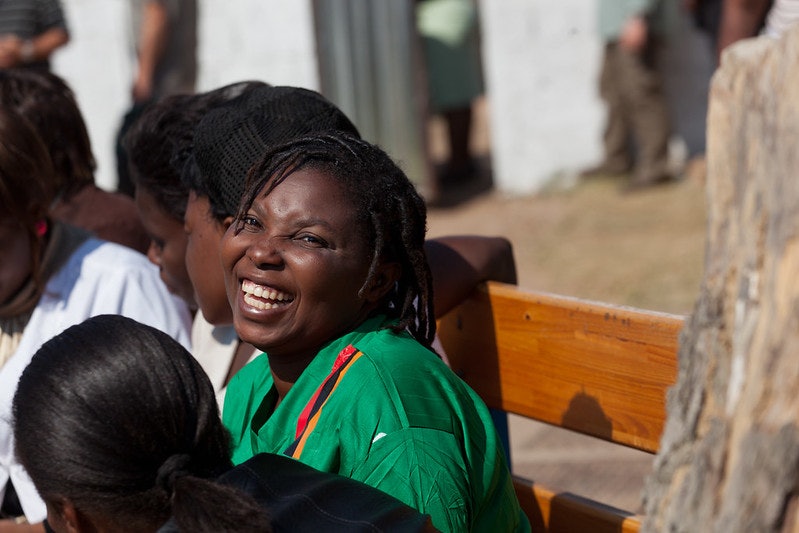Many low- and middle-income countries were experiencing unprecedented death and despair in 2003 because of the HIV/AIDS pandemic. The United States responded through a data-driven response that changed the course of history.
Thanks to two decades of generous investment by the American people through the President’s Emergency Plan for AIDS Relief (PEPFAR) and the Global Fund to Fight AIDS, Tuberculosis, and Malaria, fewer people were newly diagnosed with HIV in 2023 than in any year since before 1990. PEPFAR has saved 26 million lives and prevented 7.8 million babies from being born with HIV since 2003. And AIDS-related deaths were at their lowest level since the peak in 2004 in the latest assessment of the global pandemic by UNAIDS in 2023.
The HIV pandemic hit Africa the hardest. While the continent is home to more than half of all people living with HIV, Africa also has made the greatest progress toward eliminating HIV as a public health threat. Since 2015, HIV infections in Africa have declined by 56%, and, for the first time in history, there are more new HIV cases outside of sub-Saharan Africa than within the region. Thanks to PEPFAR-supported programs to prevent mother-to-child transmission of the virus, the number of children infected with HIV across Eastern and Southern Africa has declined by 73% since 2010.
Figure 1: The number of new global HIV infections has declined since 1990 but is still not on track to reach the interim UNAIDS 2025 target.
Figure 2: Despite significant declines, the number of global AIDS-related deaths is not on track to meet the interim UNAIDS 2025 target.

Source: UNAIDS

Source: UNAIDS
In addition, UNAIDS projects that more than 30 million people were receiving highly effective antiretroviral therapy (ART) in 2023, a record high. This means that 77% of people with HIV were on ART last year, compared with only 47% in 2015.
But the world needs to chart an aggressive course to achieve the target set in the U.N.’s sustainable development goals (SDGs) to end AIDS as a public health threat by 2030. Despite significant investments and resources, many countries are not on track to meet the 2025 interim targets for AIDS-related deaths and new HIV infections.
High-level global and regional data can only tell us so much about the successes and struggles that really matter – the actual progress made toward ending AIDS as a public health threat in each country. In 2016, the U.N. General Assembly endorsed three ambitious goals meant to help governments, civil society, and communities focus their efforts through 2030:
- At least 95% of all people living with HIV should know their status.
- At least 95% of all people with diagnosed HIV should receive ART and continue it.
- At least 95% of all people on ART should have undetectable levels of the virus in their blood, known as viral load suppression.
Data recently published by UNAIDS show that progress toward these “95-95-95” targets is dramatically uneven. This article will use case studies to examine what national governments, donors, and communities have done in countries to support the achievement of the 95-95-95 goals. We explore what is left to do in countries that are within striking distance of meeting the targets by 2030 and what has gone wrong in countries that are still far behind. Each case study includes recommendations for urgent action.
The key findings of the “PEPFAR Beyond 2030” case studies highlight the importance of data-driven, community-focused approaches to achieve the 95-95-95 targets for HIV. Success stories like Botswana and Zambia demonstrate that reinforcing political will, tailoring interventions, and decentralizing resources have significantly reduced new infections and improved treatment outcomes. However, countries like the Philippines and Ghana remain off track, facing barriers such as stigma, inadequate policies, and limited national funding. The studies underscore the need for continuous adaptation, evidence-based policy reforms, and stronger partnerships to sustain progress and meet future goals.
| Case Study | Country | At least 95% of all people living with HIV should know their status (as of 2023) | At least 95% of all people with diagnosed HIV should receive ART and continue it (as of 2023) | At least 95% of all people on ART should have undetectable levels of the virus in their blood, known as viral load suppression (as of 2023) |
| Case Study 1:
The leaders – countries achieving the 95-95-95 targets |
Republic of Botswana | >95% | 95% | 94% |
| Republic of Zambia | >95% | 95% | 92% | |
| Case Study 2:
On the right path – countries on track to achieve the 95-95-95 targets |
United Republic of Tanzania | 87% | 82% | 79% |
| Vietnam | 94% | 78% | 73% | |
| Case Study 3:
Off-track – countries currently not close to achieving the 95-95-95 targets |
Philippines | 62% | 43% | -* |
| Ghana | 65% | 45% | 40% |
*Not available at time of publication.
Case Study #1: The leaders – countries achieving the 95-95-95 targets
The Republics of Botswana and Zambia have made steady progress toward achieving the 95-95-95 targets. Both teach us several lessons for combating HIV and the clear role of PEPFAR’s leadership:
- Granular data – disaggregated by age, sex, and geography – are critical for success and should be used to act on challenges in a timely fashion.
- Access to and adoption of services across all population groups is key.
- Data-driven policy changes and their rapid implementation across all health institutions are crucial.
- HIV services integrated into community clinics must be well-staffed, nondiscriminatory, and accessible to everyone.
- Data validation is crucial to create programming that rapidly addresses gaps in care.
- Sustained political will and domestic resource mobilization are essential to continued innovation and progress.
Case Study #2: On the right path – countries on track to achieve the 95-95-95 targets
Several countries are on the right path to meet the 95-95-95 targets by 2030 due to PEPFAR support – including the United Republic of Tanzania and Vietnam – and can teach us important lessons:
- Reformed legal frameworks and policy reforms can create long-lasting changes in HIV epidemics driven by key populations.
- Programs must continuously focus on vulnerable populations and communities at the highest risk for contracting and spreading HIV.
- Course corrections are necessary when delays in policy reforms affect progress.
- Host-country health insurance schemes can provide clear fiscal sustainability.
Case Study #3: Off-track – countries not currently close to achieving the 95-95-95 targets
Some countries are struggling to meet the 95-95-95 targets by 2030, including the Republics of the Philippines and Ghana. Without immediate change, these countries will continue to lag behind and fail to achieve international goals. Both countries teach us several lessons:
- Financial support from international and bilateral donors is not the sole ingredient to success.
- Partnerships and data-driven management are critical to running accountable programs.
- Governments and communities must implement policy changes with fidelity.
The Bush Institute would like to thank Neeta Bhandari, Senior Program Officer, Global Health at the Gates Foundation; Crystal Cazier, Manager, Business Strategy and Development, Global Tuberculosis Program at Baylor College of Medicine; and Dr. Jirair Ratevosian, Hock Infectious Disease Fellow at the Duke Global Health Institute for their review of this paper.

































